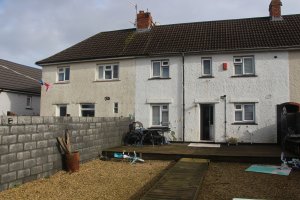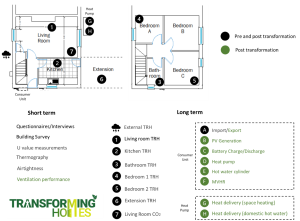Data-Driven Transformation: Unlocking the Power of Building Monitoring to Future-Proof Our Homes
Author: Dr Emmanouil Perisoglou
Monitoring plays a crucial role in providing data-driven insights that help evaluate the effectiveness of a transformation ensuring performance targets are met. Monitoring is vital for informing accurate building modelling, as it provides real-world data that enhances predictions and supports better design and retrofit decisions. During operation, monitoring becomes a powerful diagnostic tool, essential for responsive and cost-effective maintenance. By tracking real-time data, monitoring allows for a quick response to issues—including those related to safety and occupant comfort—and supports better long-term planning for sustainable operations.
Comprehensive monitoring in homes is essential for understanding how buildings truly perform in real-life conditions. Unlike basic checks, deep monitoring uses detailed data from sensors to track energy use, systems performance, temperature, humidity, air quality, and occupant behaviour over time. This helps identify exactly what works—and what doesn’t.
By closely observing how homes function, researchers and practitioners can fine-tune building models, improve retrofit and transformation strategies, and avoid costly mistakes before scaling up to larger housing programmes. Monitoring builds trust with stakeholders by providing clear, evidence-based results. Deep monitoring provides powerful information that can support the design of better, more efficient homes.
Ten demonstration homes will be delivered through the Transforming Homes project. Researchers are working closely with housing owners to deliver 10 homes in Swansea and Bristol. The team is involved in all stages of transformation: planning, design, procurement, construction, and operation—creating a continuous learning journey for all stakeholders.


Left – Swansea Demonstration Home; Joel Cady. Right – Bristol Demonstration Home; Francis Moran
Teams from Cardiff University and the University of Bath have installed short- and long-term monitoring equipment to understand the homes and their components before and after the transformation. Data can also be used to calibrate energy and hygrothermal modelling tools. Monitoring data from all the homes will be normalised and compared, with the aim of quantifying the overall impact of the transformations and the impact of each solution.
The image below outlines the short- and long-term monitoring activities and instruments used before and after the transformation. Short-term monitoring involves fabric testing and data collection from occupants. Long-term monitoring captures variables related to comfort and energy performance, requiring high-frequency data collection to draw valuable evidence. The monitoring instruments used in the homes are non-intrusive, allowing for remote sensing and silent data transmission to remote servers, thereby minimising disturbance to occupants.

Example of the monitoring plan of the Transforming Homes demos; Emmanouil Perisoglou, Juan Fernadez Goycoolea
Data collected through the different monitoring approaches is shaping the design research being undertaken on each demonstration home, ensuring that interventions are responsive to real conditions through a holistic diagnosis.
Beyond these real-life examples, the insights and lessons learned from these monitored homes will feed into a growing catalogue of design solutions aimed at scaling up housing transformation across the UK—particularly for the many homes built between the 1920s and 1940s. By providing real world evidence will help support the development of transferable solutions to provide healthier, more efficient homes for the future.
